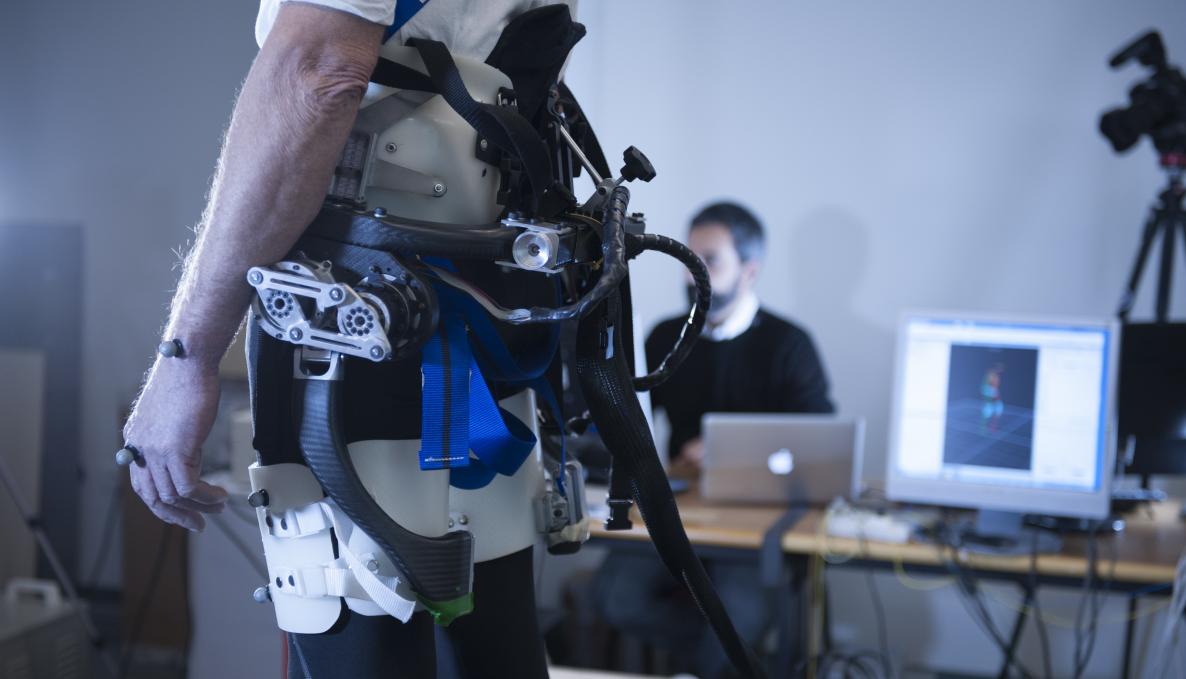Wearable Robotics: Exoskeleton prevents falls in seniors

The first smart exoskeleton that recognizes the loss of balance– and prevents falling – has been developed by researchers at Scuola Sant’Anna in Italy, EPFL (Ecole Polytechnique Fédérale de Lausanne) in Switzerland, and tested at the Rehabilitation Center “Fondazione Don Carlo Gnocchi” in Florence.
Wearable machines that enhance your movement and endurance no longer belong to the realm of science fiction. They are being developed today in the laboratory, and in this controlled setting, already prevent the elderly from falling. The study results are published in Scientific Reports journal.
Scientists at Scuola Sant’Anna in Italy and EPFL (Ecole polytechnique fédérale de Lausanne) in Switzerland have built a prototype of a smart, light-weight and easy-to-personalize exoskeleton that counteracts the loss of balance and promotes balance recovery after an accidental slip. This is a first in wearable machines, which are normally used to assist or enhance regular movement, instead of preventing an unexpected event like falling.
The exoskeleton was designed to help the elderly by preventing fall-related injuries, since seniors are involved in 40% of fatal injuries related to falling in Europe. But the exoskeleton could also be used as an aid for the physically impaired, amputees and those suffering from neurological disorders. It’s technology that will actually help people with their daily activities. The exoskeleton is wearable from the waist down, and is vastly different from the armored stuff you see in today’s science fiction movies.
“Our smart exoskeleton is light-weight and extremely easy to personalize,” says Silvestro Micera, neuroscientist and professor of bioengineering at EPFL and Scuola Sant’Anna. For this first prototype, the exoskeleton requires only a few minutes to adapt to a given patient, which involves adjusting the size for a particular user and learning the user's gait.
Science-based innovation: from human biomechanics to human-robot symbiosis
“Our study revealed that a wearable robotic platform can effectively interact with humans during reactive motor responses, such as, accidental slipping. These results open new perspectives for researchers who are expected to develop robotic platforms for enhancing human capabilities all day long,” says Vito Monaco, researcher in biomechanics of locomotion.
Monaco believes that the variable nature of human behavior represents the main challenge for researchers dealing with the design of wearable robotics. He plans to generalize the results of this study requiring the development of novel solutions so that humans and robots can seamlessly work as a single system.
Dreaming the future: a new generation of exoskeletons
Nicola Vitiello focused on robotics technologies and rehabilitation. He developed wearable and light robots for lower-limb function restoration. He believes the robotic exoskeleton may help people greatly. “Robotic technologies let us dreaming about a new generation of wearable exoskeletons that can augment users’ movement for managing daily activities and make mobility more stable and safe” says Vitiello.
How the exoskeleton works
At Hospital Fondazione Don Carlo Gnocchi in Florence, 69 year old Fulvio Bertelli puts on the wearable machine, a device equipped with motors at the hip, and braces made out of carbon fiber. The scientists adjust a few nuts and bolts, and Bertelli is ready to test his new gear. It is not yet the attire that can be discretely worn outside of the laboratory. But it works.
“I feel more confident when I wear the exoskeleton,” says Bertelli after having worn the machine on a special treadmill that can artificially make him lose his balance and slip.
The personalized exoskeleton first detects the particularities of Bertelli’s walk: the patterns of his stride known as the gait. Once this pattern is established, the system's algorithm is able to detect deviations from his normal gait i.e. the onset of a fall. When this happens, the motors push both of the thighs down, reestablishing Bertelli’s stability at the hip.
An important aspect of their system is to ensure that the exoskeleton is non-intrusive. It shouldn't unnecessarily disturb the user, particularly when the user is not falling. The next steps involve making the exoskeleton more discrete and portable for the outside world, and to test its usability with end users in real-life environments.
Exoskeletons and society
Nicola Vitiello believes that wearable robots will be the next wave of ICT technology that will pervade our society, and will help us in several domains (from healthcare to manufacturing): however, he explains that this goal will be possible only when exoskeletons will be endowed with features –like the one proved in this study- that really take into account what users can experience in the real-life unstructured environments. “This work paves the way for dreaming a completely new generation of exoskeletons that can be actually effective outside the research laboratories thanks to their ability to augment users movement and make their mobility more stable and safe” says Vitiello.
The results are published today, May 11th, in Nature Scientific Reports.
Cover photo: an exoskeleton suit (Credit: Hillary Sanctuary / EPFL)



